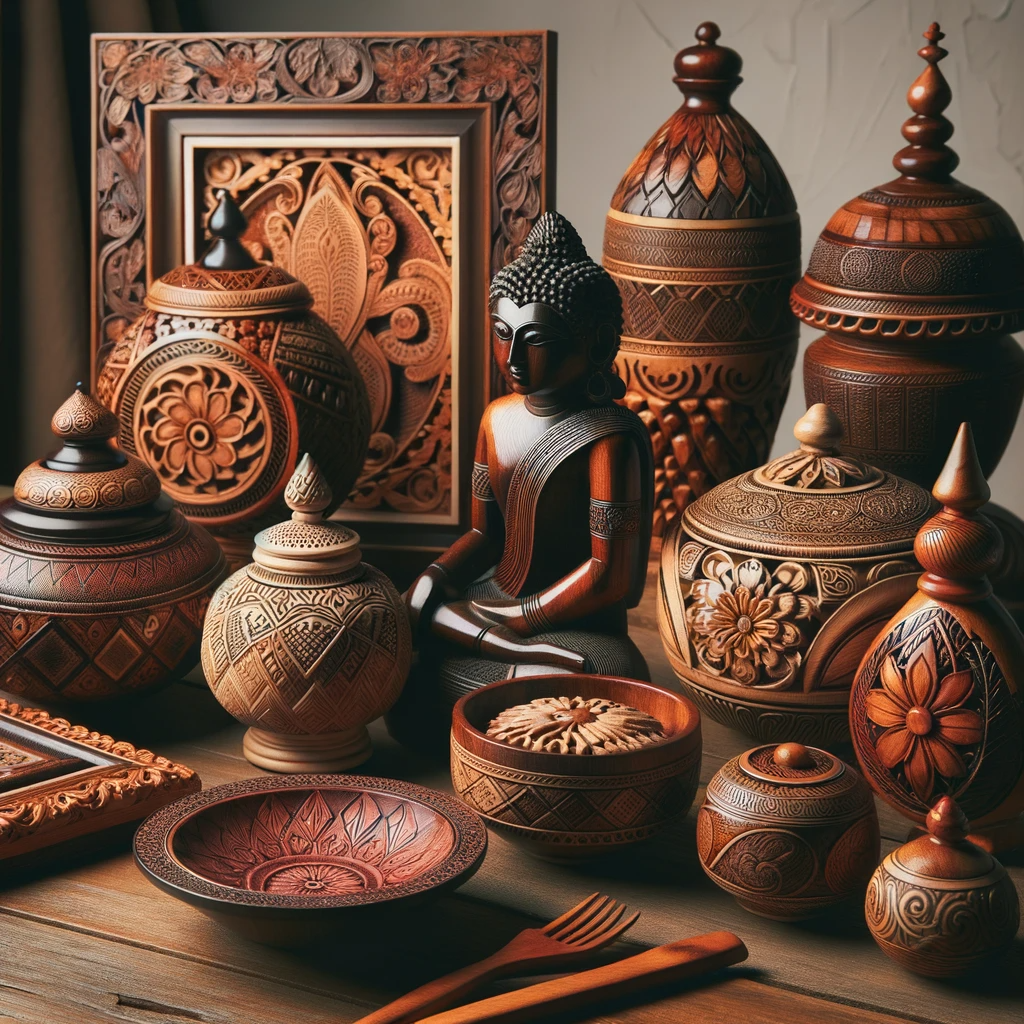Sustainable handicrafts from India represent not just products, but stories of tradition, innovation, and a commitment to the environment. Embark with us as we delve into the rich tapestry of Indian craftsmanship rooted in sustainability.
The Essence of Indian Craftsmanship
Unveiling the History and Tradition
India is a nation with an ancient legacy of art and crafts. The Indian handicrafts industry is imbued with rich histories and skills passed down through generations. Here’s a glimpse at the profound heritage:
| Time Period | Region | Craftsmanship |
|---|---|---|
| Indus Valley Civilization | Harappa | Pottery, Beadwork |
| Mughal Era | Northern India | Carpet Weaving, Metal Work |
| British Colonial Period | Pan India | Textile Industries Growth |
Artisans: The Bearers of Heritage
Artisans in India are the true bearers of the ancient crafts. They are not just creators but the guardians of our cultural heritage, which is recognized globally for its diversity and intricacy.
Sustainability in Indian Handicrafts
Defining Sustainability in Craftsmanship
Sustainable handicrafts encompass the use of eco-friendly materials and processes that conserve the environment. This aligns with global trends towards sustainability and responsible living.
The Role of Eco-Friendly Practices
By adopting eco-friendly practices, Indian artisans contribute to a greener planet. From utilizing natural dyes to recycling materials, their efforts are essential in the fight against climate change.
The Marketplace for Sustainable Handicrafts
To connect the vibrant world of Indian handicrafts with global markets while maintaining sustainability is a challenge that offers substantial rewards.
Discovering the Platforms for Indian Crafts
The digital age has opened up new platforms for craftsmen to sell their products worldwide, with e-commerce and social media playing pivotal roles.

Building the Bridge: Export Potential
Indian handicrafts have a significant export potential. By leveraging this potential, India can position itself as a leader in sustainable and ethical crafts.

Case Studies: Success Stories in Sustainability
From Local to Global: Celebrating Achievements
We have witnessed incredible success stories where local artisans have reached global markets, thus validating the allure and viability of sustainable handicrafts.
Empowering Communities Through Sustainable Crafts
Sustainable practices empower communities, ensuring livelihoods while preserving the environment. Here are key projects that have made substantial impacts:
| Organization | Initiative |
|---|---|
| SEWA | Women Empowerment |
| Kala Raksha | Tradition Preservation |
Materials and Techniques: The Fabric of Innovation
Sourcing Organic and Upcycled Materials
The choice of materials plays a crucial role in sustainability. Indian artisans are increasingly turning towards organic and upcycled materials, reducing the ecological footprint of their crafts.
Ancient Techniques in Contemporary Design
India’s rich traditions in handicraft employ techniques that have stood the test of time. Artisans are now merging these age-old techniques with contemporary designs to create unique and innovative products.
Challenges in Sustainable Handicraft Promotion
Balancing Tradition and Modern Market Demands
As we promote sustainable handicraft, it’s imperative to strike a balance between preserving traditional methods and meeting modern market demands.
Overcoming Logistical and Quality Hurdles
Ensuring consistent quality and managing logistics are two significant challenges in the promotion of sustainable handicrafts. It requires meticulous planning and quality control to overcome these hurdles.
Collaborations and Partnerships
To foster a sustainable environment for handicrafts, collaborations and partnerships between governmental organizations, NGOs, and the private sector are paramount.
Partnering for Progress: Success Stories
Stories of successful partnerships showcase the power of collaboration in bringing sustainable Indian handicrafts to the forefront of international markets.
NGOs and Enterprises: Catalysts for Change
NGOs and private enterprises have been catalysts for change, helping artisans adopt sustainable practices and gain access to global markets.
Marketing and Branding Strategies
Narratives that Sell: Storytelling in Handicrafts
Storytelling in marketing is a powerful tool that brings life to products. It can significantly boost the appeal of sustainable handicrafts in India, making them more than just items to purchase.
The Importance of Brand Identity in Sourcing
A strong brand identity is crucial for the success of sourcing initiatives. It helps in building trust and recognition among global buyers.
Legal Framework and Trade Policies
Understanding the legal frameworks and trade policies is necessary for navigating the complexities of international trade in handicrafts.
Navigating the Legal Aspects of Export
It is important for artisans and exporters to be well-versed with the legalities of export procedures, to avoid complications and ensure smooth operations.
Trade Agreements: Boons for Sustainable Handicrafts
International trade agreements can act as a boon for sustainable handicrafts, opening up new markets and providing competitive advantages.
Educating and Engaging the Consumer
Bringing change in consumer behavior is essential for the growth of sustainable handicrafts. Educating them about the impact of their choices is a step towards this change.
Awareness Campaigns and Consumer Education
Conducting awareness campaigns and educating consumers about the benefits of sustainable products can lead to more responsible purchasing decisions.
The Impact of Consumer Choices on Sustainability
Every purchase decision made by a consumer can contribute to sustainability. It’s a powerful way to support artisans and the environment.
The Role of Digital Transformation
Digital tools have reshaped the handicraft industry, offering new ways to connect artisans with global markets.
E-commerce: A Digital Marketplace for Crafts
E-commerce platforms have emerged as effective digital marketplaces for Indian artisans to sell their sustainable handicrafts to a global audience.
Social Media and Online Communities in Promotion
Social media and online communities play a critical role in promoting sustainable handicrafts, allowing artisans to showcase their stories and gain visibility.
Financial Aspects and Investment Opportunities
Funding Innovation and Sustainability
Investing in sustainable handicrafts not only fosters innovation but also supports the ethical and eco-friendly ethos of the industry.
Return on Investment in Sustainable Practices
The return on investment in sustainable handicrafts goes beyond financial profits. It includes environmental conservation and social impact.

Impact on Cultural Heritage Preservation
Craft Preservation as Cultural Diplomacy
Promoting sustainable handicrafts serves as a form of cultural diplomacy, extending India’s cultural heritage to an international audience.
Celebrating Diversity Through Handicrafts
Sustainable handicrafts are a celebration of India’s diverse cultural fabric, showcasing the country’s multifaceted artistic expressions to the world.
Quality Control and Certification
Ensuring Excellence in Handcrafted Products
To maintain the high standards expected of Indian handicrafts, implementing stringent quality control measures is essential for artisans and exporters.
The Significance of Certifications
Certifications play a significant role in the sustainability narrative, providing credibility and confidence to consumers and trade partners alike.
The Future of Sustainable Handicrafts in India
Trends and Forecasts
We’re looking at a future where sustainable handicrafts are not just a niche market but a significant and rapidly growing segment of global trade.
The Vision for a Sustainable Handicrafts Industry
Our vision for the future is an industry that thrives on sustainability, celebrates tradition, and embraces innovation, positioning India as a beacon of eco-conscious craftsmanship.
Impact on Cultural Heritage Preservation
Craft Preservation as Cultural Diplomacy
The practice of sustainable handicrafts transcends mere commerce; it embodies an act of cultural diplomacy. By choosing sustainability, India presents itself as a steward of ecological and cultural richness, thus enhancing its global standing.
Celebrating Diversity Through Handicrafts
Handcrafted goods are not just commodities; they are cultural artefacts. Through sustainability, we celebrate India’s diversity, showcasing a plethora of regional designs, techniques, and materials that promise to enchant the world.
Quality Control and Certification
Ensuring Excellence in Handcrafted Products
Quality control ensures that the narrative of sustainability is matched by superior craftsmanship. Excellence in handicrafts is not up for compromise — it is a commitment to the buyer and an ode to the maker’s pride.
Key Takeaways:
- Maintaining high standards ensures continued demand
- Artisans are empowered to deliver products that stand the test of global markets
The Significance of Certifications
Certifications such as Fair Trade and Organic labels enhance trustworthiness, thus helping Indian handicrafts gain a competitive edge while affirming their dedication to sustainability.
Key Takeaways:
- Certifications are a testament to quality and sustainability
- They authenticate traditional practices and modern values, inviting discerning consumers
The Future of Sustainable Handicrafts in India
Trends and Forecasts
As global awareness rises, the demand for sustainable products only grows. Indian handicrafts face a future ripe with the possibility of becoming dominant players in the global sustainable goods market.
Key Takeaways:
- The sustainable handicrafts market is poised for substantial growth
- Embracing eco-friendly practices is essential for future competitiveness
The Vision for a Sustainable Handicrafts Industry
Our collective vision is robust: an industry that harmoniously marries the past with the present, tradition with innovation, creating a sustainable roadmap for India’s handicraft sector. This is not just a dream — it is a tangible, achievable future.
Key Takeaways:
- Sustainable practices are the linchpin for the handicrafts industry
- India is on the cusp of setting a global example in eco-conscious craftmanship
Conclusion
Sustainable handicrafts from India are not merely products but emblematic of a greater ethos — one that respects the environment, celebrates heritage, and nurtures the future. Our vision is harbored by a concerted effort that involves artisans, markets, and consumers—each playing a vital role in this sustainable symphony.
This article has woven together the various strands that characterize India’s commitment to eco-friendly and ethically sourced handicrafts, portraying a vibrant tapestry of potential and prosperity. The role of each stakeholder is clear: from the artisan to the exporter, from the policy-maker to the consumer — each must act with foresight and responsibility.
By maintaining stringent quality, upholding the crafts’ authenticity, embracing digital platforms, and educating consumers, Indian sustainable handicrafts can achieve not just market success but also contribute significantly to global sustainability goals. It’s time for the world to embrace the marvels of Indian craftsmanship, rooted in the principles of sustainability and buoyed by the wings of innovation and enterprise.
Traditional practices, when adapted to modern sustainability standards, can lead to a brighter and greener future, not just for the industry, but for the global community as a whole.
The discussion reinforces the idea that sustainable handicrafts are more than just tangible items; they carry the spirit of India – its cultural richness, ethical values, and innovative spirit – showcasing to the world a new dimension of luxury that is conscientious and responsible.
As we draw this article to a close, remember that by embracing sustainable handicrafts, we invest in more than just beautiful objects; we invest in stories, people, and the planet. We thread a bond that connects us to the artisans’ hands and heart, making each sustainable purchase a step towards preserving the exquisite legacy of India’s artisans for generations to come.
For further information on topics related to Indian handicrafts, artisanship, and sustainability, visitors are encouraged to explore other insightful articles, such as the evolution of Indian textile exports, India Textile Sourcing Fair, and fabric sourcing in India, featured on Product Sourcing India.
With this comprehensive and detailed approach, we aim to impress upon the readers an appreciation for sustainable handicrafts — a true gem in the crown of Indian culture and commerce.






